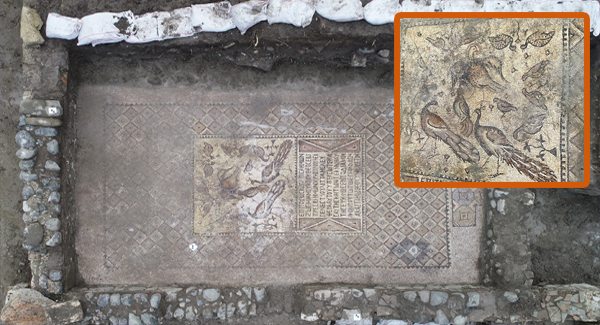Throughout history, humans have constructed monumental structures that continue to baffle modern experts due to their scale, precision, and mysterious origins. From massive stone blocks moved without modern tools to enigmatic carvings, these sites raise questions about lost technologies and ancient ingenuity. Below, we explore some of the most puzzling ancient structures, their mysteries, and the theories surrounding their creation.
Ain Dara Temple, Syria
The ancient temple of Ain Dara in Syria, dating back over 3,300 years, is renowned for its massive footprints carved at the entrance. These oversized imprints have sparked debate about their purpose. Some scholars suggest they symbolize gods entering the temple, with one theory linking them to the goddess Ishtar, associated with fertility. However, others argue that later Assyrian additions, including Ishtar’s carving, may not connect to the footprints. Local legends propose that giants or a clawed-footed deity left the marks. Despite a 2018 Turkish air raid damaging the site, these footprints endure, continuing to intrigue researchers.
Puma Punku, Bolivia
Located 12,800 feet above sea level in the Andes Mountains, Puma Punku is an ancient Bolivian site featuring stones weighing up to 131 tons. Built around 1,400 years ago, the precision of the stonework is astonishing, with cuts so exact they resemble modern laser technology. The absence of trees in the region rules out the use of wooden rollers, leaving the method of moving these massive, sometimes magnetic, stones a mystery. Theories range from forgotten techniques to speculative extraterrestrial assistance, but the site’s engineering remains unexplained.
Masuda no Iwafune, Japan
In the village of Asuka, Japan, the Masuda no Iwafune, or “Rock Ship,” is a colossal stone structure measuring 11 meters long, 8 meters wide, and nearly 5 meters high, weighing 800 tons. Dating back to around 250 AD, its purpose is unknown. While some link it to Buddhist practices due to nearby shrines, its design predates typical Buddhist architecture. Theories suggest it may have been part of a forgotten ritual or served an entirely different function, leaving its origins a subject of speculation.
Nan Madol, Micronesia
Nan Madol, an ancient city off the coast of Pohnpei, consists of about 100 man-made islets built with massive basalt columns, some weighing tons, without mortar. Constructed around 1,400 years ago, it likely served as a hub for the Saudeleur chiefs to control their rivals. Local legends speak of giant birds transporting the stones, but the true method remains unknown. Some even connect Nan Madol to mythical lost continents like Lemuria or Mu, though no evidence supports this.
Sacsayhuamán, Peru
Near Cusco, Peru, Sacsayhuamán’s massive polygonal walls, part of the Inca capital, feature boulders so precisely fitted that not even a needle can pass between them. Some stones reach 6 meters tall, with walls stretching up to 400 meters. The Incas’ ability to shape and move these stones without modern tools stunned Spanish conquerors, who speculated demonic involvement. The construction techniques remain a mystery, showcasing the Incas’ advanced engineering.
Moray Terraces, Peru
Located 50 kilometers northwest of Cusco, the Moray Terraces form a circular, amphitheater-like structure with terraces descending 150 meters. The design creates microclimates, with a temperature difference of up to 15°C between the top and bottom. Experts believe the Incas used these terraces to experiment with crop growth in varying conditions, supported by evidence of imported soil. The terraces’ drainage system ensures water never pools, highlighting the Incas’ agricultural ingenuity.
Serapeum of Saqqara, Egypt
Near the Pyramid of Djoser in Saqqara, Egypt, 24 massive granite boxes, each weighing over 100 tons, were found in a hillside cave. These airtight, coffin-shaped containers, with lids weighing 30 tons, feature machine-like precision. Poorly inscribed hieroglyphs offer little clarity on their purpose. Some speculate they were not Egyptian but inherited from an earlier, possibly extraterrestrial, civilization, though no evidence supports this.
Lalibela Churches, Ethiopia
In Lalibela, Ethiopia, 11 monolithic churches carved from single rock formations, some extending 40 to 50 feet below ground, date to the 12th century. Attributed to King Lalibela, their construction is attributed by some to divine assistance, with legends claiming angels helped complete them in one night. The precision and scale of the carvings, achieved without modern tools, continue to amaze, and the churches remain active worship sites.
Borobudur, Indonesia
Borobudur, the world’s largest Buddhist temple, built over 1,200 years ago in Indonesia, features a complex design resembling a mandala. Initially planned as a single massive stupa, it was modified to include three smaller stupa levels around a central dome. With over 500 statues, including an unfinished Buddha, its purpose—possibly for meditation—remains uncertain. The Shailendra dynasty’s motives for its construction and abandonment are still debated.
Longyou Caves, China
In Xianju, China, over 30 hand-carved siltstone caves, some 30 meters deep, were discovered after draining a pond. Dating back over 2,000 years, these caves show no signs of construction debris, and their purpose—possibly storage, ritual sites, or observatories—remains unknown. The scale of the effort, requiring thousands of workers, and the absence of excavated rubble deepen the mystery.
Goseck Circle, Germany
Dating to 4,900 BC, the Goseck Circle in Germany is a 75-meter-wide ditch with wooden palisades aligned to mark solstices. Some believe it was a solar observatory, while others suggest it was a site for human sacrifice, supported by findings of human bones with cut marks and evidence of ritual fires. Its precise alignment reflects advanced astronomical knowledge for its time.
Moai of Easter Island, Chile
Easter Island’s moai, nearly 1,000 stone statues with oversized heads, were carved from single blocks and moved across the island. The largest, Paro, stands 10 meters tall and weighs 82 tons, while an unfinished statue could have reached 21 meters. Theories about their transport range from human ingenuity to speculative external help, but the Rapa Nui’s methods remain unclear.
Yonaguni Monument, Japan
Off Japan’s Yonaguni Island, an underwater formation resembling a lost city—with columns, platforms, and a pyramid—sparks debate. Some argue it’s a natural formation shaped by earthquakes and currents, citing parallel fractures. Others believe its precise angles and holes suggest human craftsmanship, possibly from a forgotten civilization. Its true nature remains unresolved.
These ancient structures, from Syria to Japan, continue to challenge our understanding of the past, hinting at lost technologies and cultures that may forever remain a mystery.






















